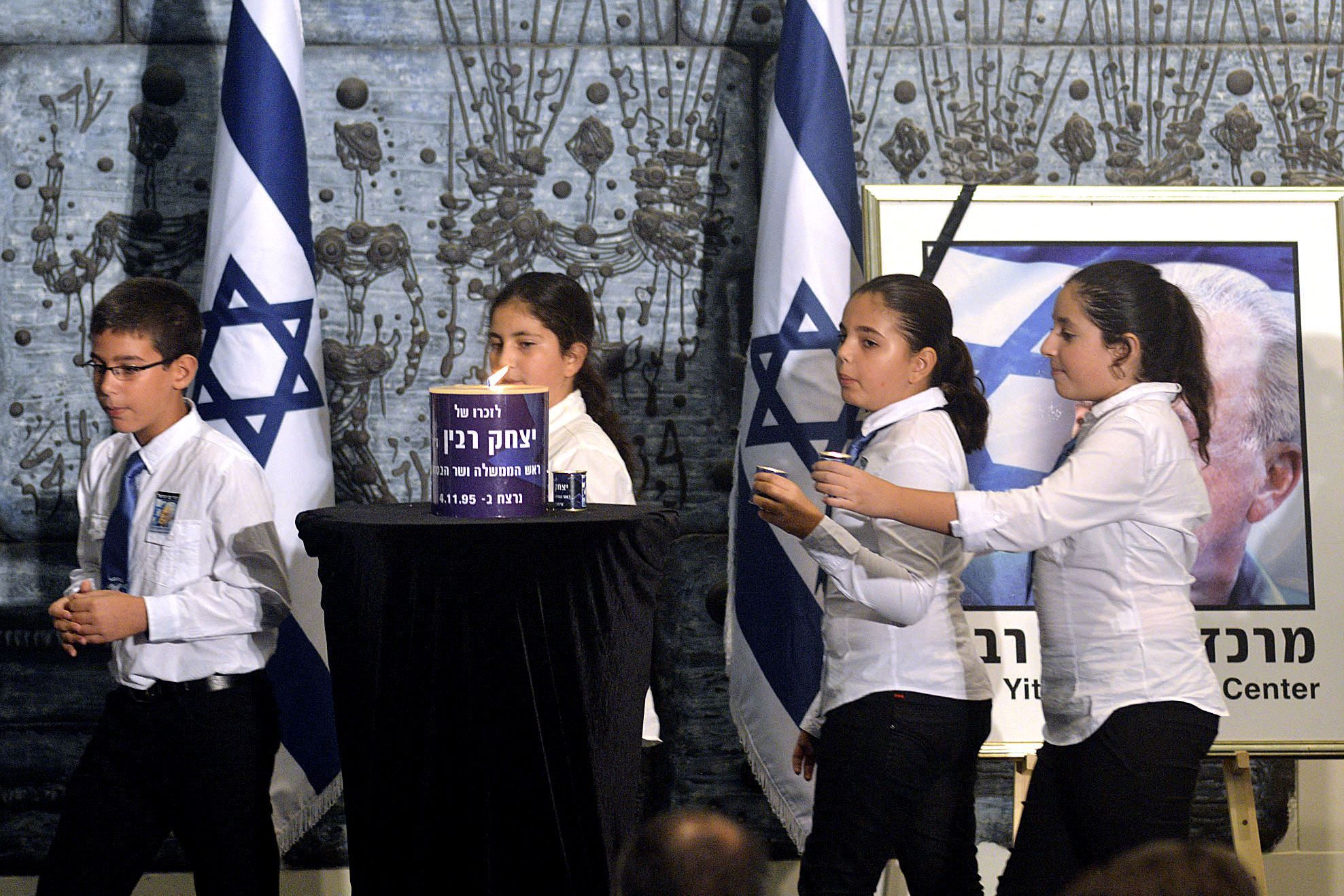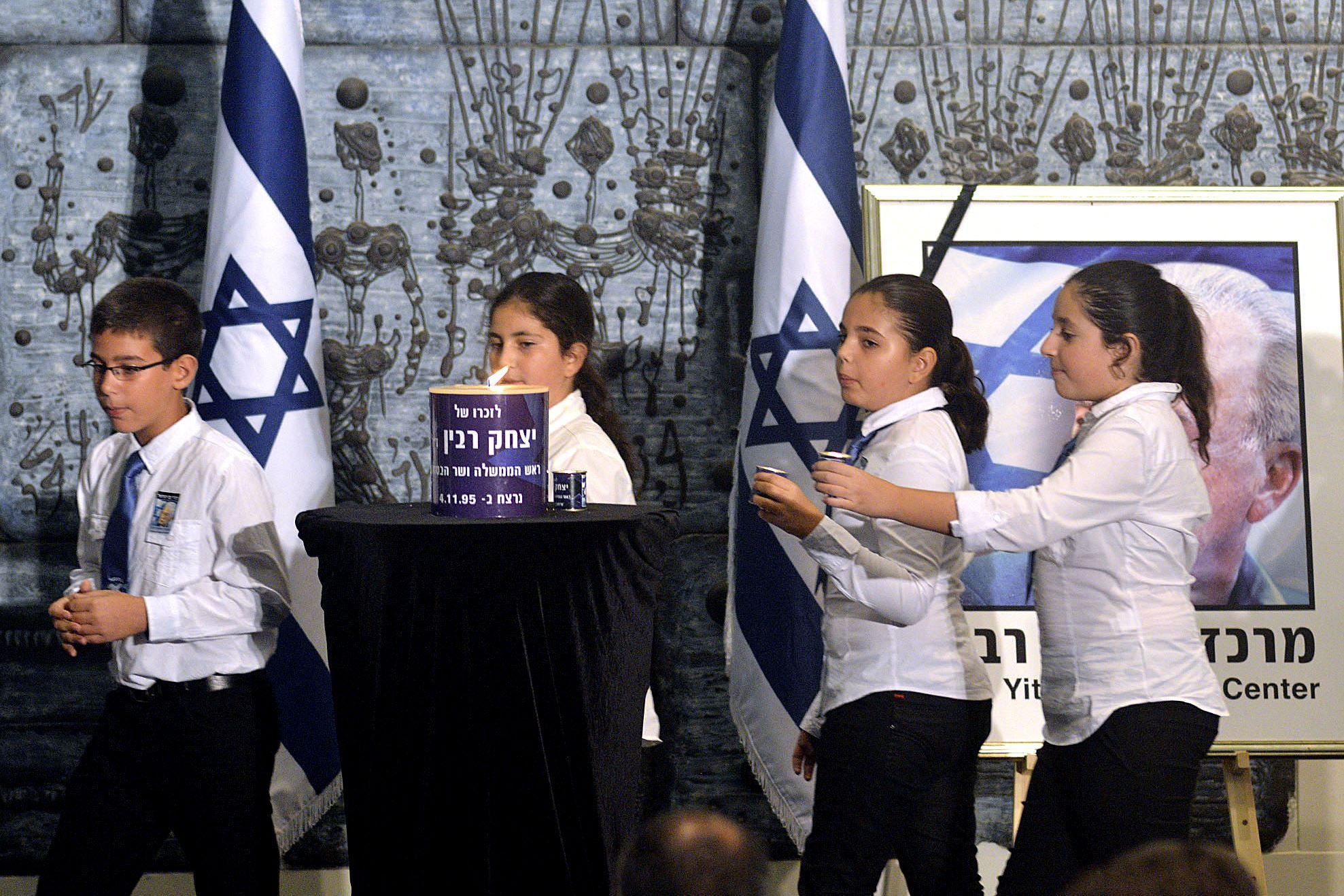JERUSALEM — A slice of the Israeli political elite marked the 20th anniversary of the assassination of Prime Minister Yitzhak Rabin today, less than a day after a protest march signaled to some a revival of the long-beleaguered peace movement.
Israeli President Reuven Rivlin and former Prime Minister Shimon Peres headlined an hour-long event at the president's residence. Separating the speeches were mournful songs, including a rendition of Song for Peace, which Mr. Rabin sang in 1995 with assembled entertainers and politicians just minutes before he was gunned down by a Jewish extremist.
The singers, backed by 18 children from the Yitzhak Rabin School in Ashdod, sang the usual Hebrew words but added a final verse in Arabic. “This is the first time in my life I heard that in Arabic,” said one of the attendees.
A video showing scenes from Mr. Rabin’s life as a soldier and statesman included clips from his speeches. “At an age where first love blooms, at the tender age of 16, I was handed a rifle so that I could defend myself,” Mr. Rabin said in one of the clips. “That was not my dream.”
In 1967, Mr. Rabin was the Israeli Defense Forces chief of staff and pushed for the ultimately successful pre-emptive strike against Egyptian and Syrian units that were preparing to attack. Israel captured the West Bank, Gaza Strip, East Jerusalem and the Golan Heights then, along with the Sinai Peninsula, which it later returned to Egypt.
He served as prime minister in the 1970s and was elected again in 1992. He shook hands with Palestinian Chairman Yasser Arafat in 1993 and finalized the Oslo Accords which were heralded, at the time, as steps toward enduring peace.
But as negotiating teams got close to a deal on the contentious issue of the status of Jerusalem, he was assassinated by student Yigal Amir. Mr. Rabin died on Nov. 4, 1995, but the Hebrew calendar anniversary is today.
His successor, Mr. Peres, didn’t have the political muscle to continue the peace process, and was supplanted in 1996 by the conservative Likud Party’s Benjamin Netanyahu, who is the prime minister today.
Attending today were Rabin family members and political leaders mostly from the left, including opposition leader Isaac Herzog. Mr. Rivlin was an ideological exception, as a member of the Likud party known for his simultaneous defense of the rights of Palestinians and opposition to an independent Palestinian state.
“Another voice here”
The commemoration occurred less than 24 hours after a Tel Aviv peace march led some participants to believe that the Israeli left may only be mostly dead.
The combination of scattered violence across Israel and the West Bank and the anniversary seemed to galvanize a long-dormant vanguard. While some predicted the march would only attract a few hundred, thousands showed up.
“This is very important, the idea that we’re 20 years after the death of Yitzhak Rabin, who did [the] Oslo [peace accord with the Palestinians], and we haven’t gotten anywhere,” said Hermine Antelman, 62, a behavior specialist from Yafo who used to live in Philadelphia. “The last month of terror attacks, every side tries to up the ante. ... It’s time to stop all of that.”
The event started at Rabin Square, the site of the assassination. After clogging Saturday night traffic for roughly half an hour, it ended near numerous government offices, notably including the towering Defense Ministry headquarters.
Ricardo Baran, 64, of Kibbutz Hatzor, said he used to march a lot, but Saturday’s was his first such event in five years. “Something happened that it came to the point where I have to put my conscience a little bit to rest,” he said. “I believe the whole situation here is slowly, or maybe rapidly, deteriorating.”
Irit Ezra, 41, a graphic designer from Tel Aviv, cycled to Rabin Square with her young daughter, Alma. “I am against everything that happened, all the violence, and I do believe in peace and I do believe we have to talk and do something,” she said. Will the situation improve? “I’m afraid it won’t, which makes it more important, not for me, but for her,” she said, gesturing to Alma.
“You hear every day the voice of fear, the voice that calls for revenge, the voice of hatred,” added Meirav Maor, 33, a Tel Aviv bar employee. “You hear another voice here.”
Some of the chants decried a “racist government,” others declared that Jews and Arabs are not enemies, and a few proclaimed that Jerusalem could be the capital of two countries, not just one.
Adam Shperber, 35, a hostel food manager from Tel Aviv, said he was there in 1995 when Mr. Rabin was assassinated at what was then Kings of Israel Square.
“There were like a billion people!” he recalled. The Song for Peace singalong that night seemed to him “cheesy, because I was going to a lot of protests.” As the event ended, and people started to slowly disperse, he said, “I heard a boom and thought maybe someone was giving the police some trouble. I could not imagine that history had changed at that moment.”









